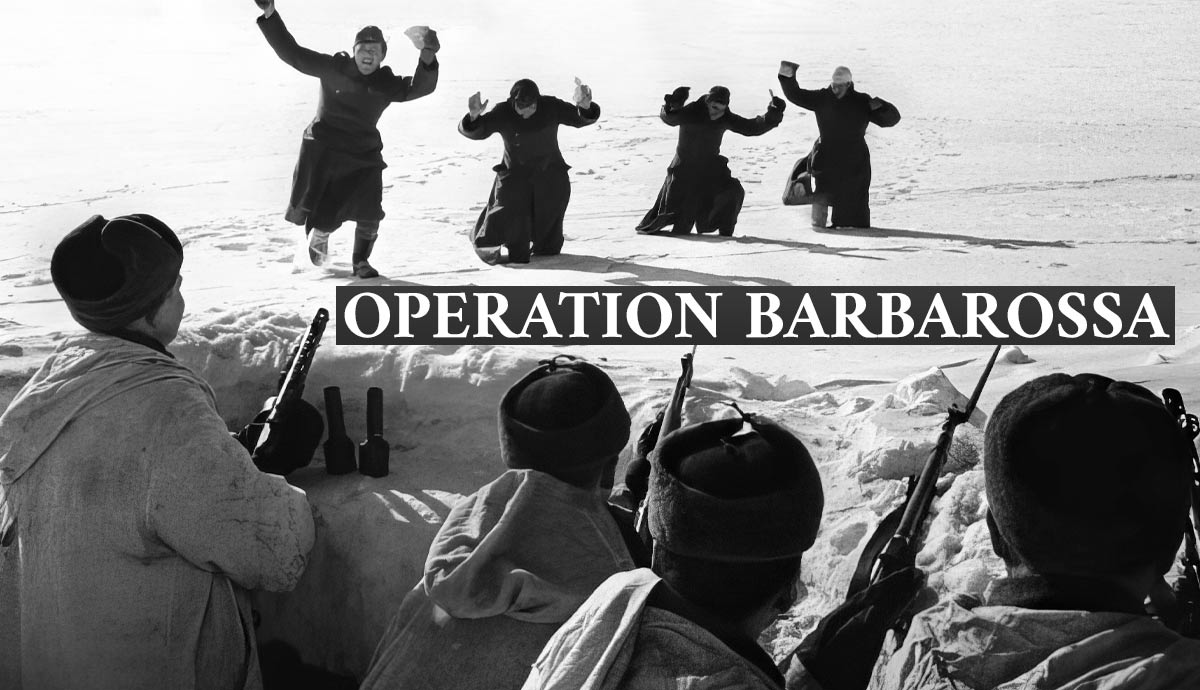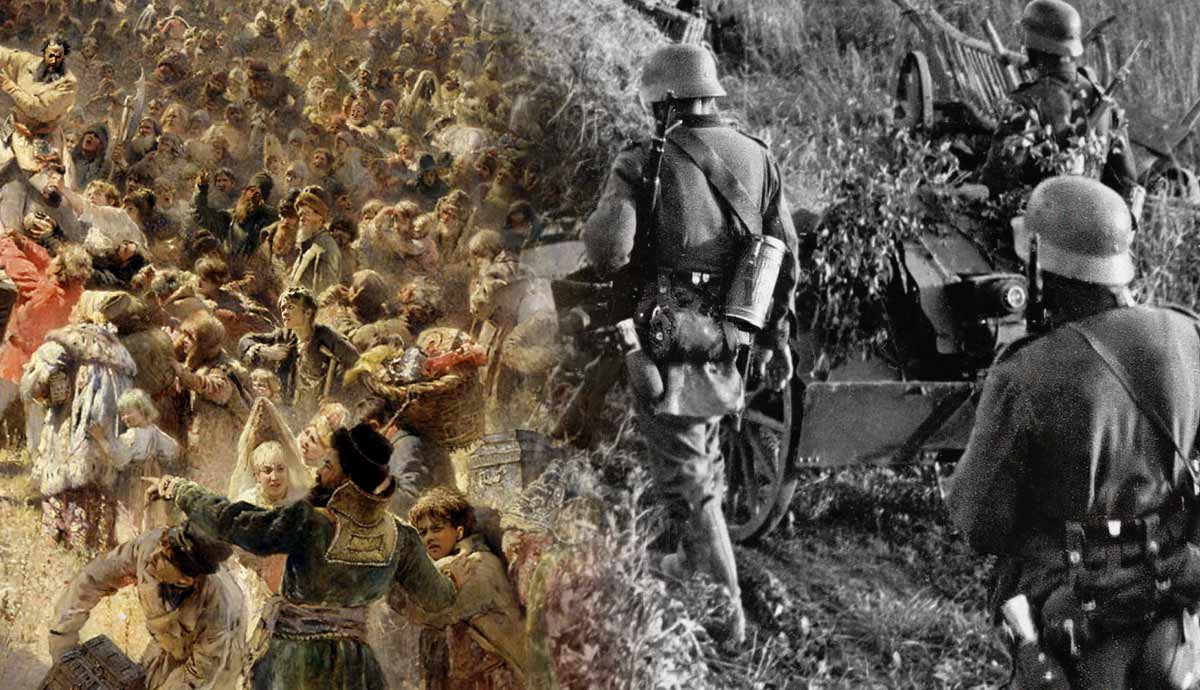
The Eastern Front was, by far, the biggest part of the Second World War. A vast part of the German war effort went into fighting the Soviet Union from 1941 to 1945. The invasion of the Soviet Union was unprecedented. With 3.8 million Axis personnel, it was the biggest invasion in history. The Soviets were underprepared for a surprise of this magnitude, and the German forces made incredible gains that outstripped even their most optimistic projections. But no matter how stunning these victories were, it wasn’t enough. This is the story of Operation Barbarossa.
Hitler’s Goals

The Soviets were not completely unaware of Hitler’s invasion plans. They knew that war would come with Germany at some point. Josef Stalin, however, had not expected it to happen as soon as it did. He was under the impression that the Soviet Union would have plenty of time to prepare, so when Germany launched the invasion on June 22, 1941, the Soviets were caught off guard. Stalin retreated to his dacha (summer house) and drank himself into a stupor, refusing to address the reality of the situation.
German intentions for the Soviet Union were no secret. Hitler had already laid out his beliefs in his book, Mein Kampf, which he wrote in 1924 while sitting in Landsberg Prison. His desire was for Lebensraum—living space—in the east, which would form the basis of a vast Germanic empire. For this goal to be realized, the Soviet Union would have to be defeated and its inhabitants driven away, enslaved, or wiped out.
As such, the conquest of the Soviet Union was Hitler’s primary objective from the very start of the war. Operations against the Western Allies were only conducted in order to safeguard the German efforts in the East.

From an ideological standpoint, Nazism, a distinct form of German fascism, was a mortal enemy of communism. This gave Hitler another reason why the Soviet Union needed to be conquered. Along with the belief in racial superiority and the imagined need to rid the East of Jews, Slavs, and other “undesirables,” the invasion of the Soviet Union was an endeavor that found much support within the German populace.
There was also the firm belief that unless Nazism dealt with communism, communism would deal with Nazism. The Soviet Union was expansionist and envisioned a world where communism was everywhere. War was absolutely inevitable, and Hitler wanted to strike first.
From an economic perspective, the case could not have been more clear. Germany’s expansion in Western and Central Europe and the occupation of new territory was a drain on German resources. While German industrial might had surged in the previous years, the gap between Germany and its enemies was now closing. Hitler felt compelled to do something before Germany fell behind, having to expend vast amounts of resources on maintaining its empire while the despised communists to the east became too powerful to conquer.

Meanwhile, trade between Germany and the Soviet Union was booming. With the expansion of the Reich, the drop in food production became a worrying development. Germany imported substantial amounts of food from the Soviet Union, while Germany provided the Soviet Union with industrial goods. In effect, the Soviet Union was feeding the Reich while Germany was arming the Soviet Union. Both countries were preparing each other for a war against each other.
Hitler and his ministers feared the results of this state of affairs, and they were acutely aware of the risk of becoming dependent on the Soviet Union in much the same way as the United Kingdom had become dependent on the United States.
As such, the Soviet Union needed to be conquered. And it needed to happen sooner rather than later.
Soviet Inadequacies

When the invasion began, the Soviets were caught off guard. Less than two years prior, the Soviet Union had joined Germany in invading Poland. The Soviets had neglected the proper fortification of their new border with Germany, and efforts to reinforce other borders had been lackluster.
The Soviets were also outnumbered during the whole campaign, only managing to muster 2.9 million soldiers against the German 3.8 million at the start of the invasion. Due to Stalin’s purges and a massive reorganization of the officer class, these soldiers were poorly led and lacked any ability for cohesive defense. Confused by contradictory orders and the poor tactics and strategies of superior officers, the Soviet casualty rate would be enormous. Hundreds of thousands were captured due to the incompetence of their leaders.
Hitler’s assessment of the situation could be summed up in one of his famous quotes: “We only have to kick in the door and the whole rotten structure will come crashing down.”
The German Plans

With the complete success of German ground operations in 1939 and 1940, German tactics and capabilities were proven. With this in mind, the Germans began drawing up plans in June 1940 for an invasion of the Soviet Union. Hitler believed that after defeating the Soviet Union, the British would sue for peace and that even if they didn’t, the new access to resources would allow the Germans to defeat the British Empire.
On December 5, the plan was finished and forwarded to Hitler. Hitler renamed Operation Otto to Operation Barbarossa in honor of the medieval king of the Holy Roman Empire.
On December 18, Hitler issued the Führer Directive 21 authorizing the invasion of the Soviet Union, and in March of the following year, he issued another directive authorizing the invasion to be one of total annihilation. From the outset, genocidal acts were expected. In fact, drawn from the SS divisions, Einsatzgruppen—paramilitary death squads—trailed the German army, committing acts of genocide and ethnically cleansing the conquered territory.
From Hitler’s perspective, victory would only be achieved through destroying the Red Army. Many of his top generals disagreed, claiming that the key to victory lay in taking key territories. They were unable to dissuade Hitler from these beliefs, which ultimately governed how the invasion was carried out.
Nevertheless, three areas were deemed necessary for the Germans to focus on to achieve their war goals: Leningrad, the Donbas, and Moscow. Toward these territorial objectives, Operation Barbarossa called for the German invasion to be split into three main thrusts. Army Group North, Army Group Center, and Army Group South.
The Invasion Begins

On June 22, 1941, Operation Barbarossa was launched along a 1,800-mile front. The speed of the German advance stunned the Soviets. Even Stalin was taken by surprise.
The initial stages of the campaign were an absolute disaster for the Soviets. Hundreds of thousands of Soviet soldiers were captured as the German war machine surged forward, encircling Soviet armies in pincer movements so quickly that the Soviets did not have time to react.

The speed of the advance was the result of the German Blitzkrieg tactic, where various elements of the armed forces were used together in such a way as to achieve maximum effect, overwhelming the enemy with firepower. The Luftwaffe struck so fast that much of the Soviet air force was destroyed on the ground. German air superiority was achieved almost immediately after the invasion began. With the threat of the Soviet Air Force neutralized, the Germans had the operational space to complete swift, far-reaching maneuvers that would have been otherwise extremely risky.
The biggest encirclement in history occurred at the end of September when generals Ewald von Kleist and Heinz Guderian managed to trap more than half a million Soviet soldiers in the city of Kyiv.

The rapid advance and the encirclement of large Soviet armies created other problems that needed to be addressed. By August, the Germans began to feel the effect of logistics and supply issues. Although hundreds of thousands of Soviets had been taken prisoner in massive encirclements, there were still large groups holding out. From within these pockets, the Soviets attacked and harassed the German supply lines.
In addition to this problem, getting supplies to the frontline was hampered by rainy weather, turning the fields and roads into mud, as well as the significant issue of the Russian train gauge being wider than the German gauge. Rolling stock became useless once it reached the Soviet border, and supplies had to be transported via alternative means.
Despite warnings from his generals not to do so, Hitler halted the advance of the Army Group Center and had hundreds of thousands of German soldiers diverted to the north and the south to deal with the encircled Soviet armies still resisting. This maneuver cost valuable time and led to even greater consequences than the Germans had anticipated.
Soviet Defiance

The German belief was that the Soviet army was relatively the same size as the German army and that once three million soldiers had been captured or killed, the entire country would capitulate, possibly even rising up against the communist regime. This simply did not happen.
Expecting a total of 50 Soviet divisions to be mobilized from east of the Urals, the Germans were surprised to find the Soviets had mustered 200 divisions and used the pause from Army Group Center as an opportunity to launch their own counteroffensive.
Despite Soviet efforts, Army Group Center under the command of Field Marshal Fedor von Bock pushed forward, encircling another 600,000 Soviets around Vyazma. The victory, however, came too late and was only completed in late October. By this time, the German troops were utterly exhausted, and the ground had turned to mud.
New Soviet armies appeared, but the prize of Moscow was so close the Germans pressed on instead of establishing defensible lines for the winter.
The forests outside Moscow slowed the German pace to a painful crawl, and as winter set in and Soviet attacks increased, the situation for the Germans turned into a disaster. Expecting the Soviets to surrender sooner, the Germans had deemed it unnecessary to equip their troops with adequate winter clothing. Their enemies, however, were well suited to fighting in the cold and took advantage of the situation, stopping the Germans dead in their tracks.
On December 6, General Georgy Zhukov, commanding the armies in and around Moscow, launched his counteroffensive and drove the Germans back.

With the winter halting the German advance all along the frontline and Soviet troops being constantly brought from the rear, the German offensive stalled and came to a grinding halt. The sweeping maneuvers and stunning successes of the first few weeks gave way to bitter cold and misery, and the Soviets began to find more confidence.
Barbarossa had been a failure. Hitler and his supporters had completely underestimated the Soviet will to fight. The country had not collapsed as predicted but fought on, no matter the cost.
The war would hang in the balance until 1943, when the Germans were soundly defeated at Stalingrad and Kursk. These battles would mark the points of Soviet supremacy. Less than two years after the Battle of Kursk, Soviet tanks would be rumbling through the streets of Berlin.











